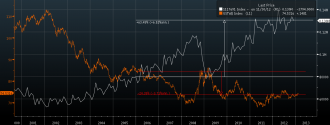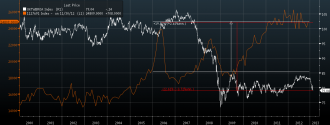This is my second post for ForexLive and I fear that my cultural references are already giving my age away…
Sade last week, today the 1983 film that kicked off Tom Cruise’s career – Risky Business – that sees him dance around a living room in his underwear to “Old Time Rock and Roll”.
What it demonstrates (somewhat superfluously but the trailer will put a smile on your face) is that all business and financial decisions have risk. And that risk must be compensated by return. Using a film as the example, Tom Cruise’s character Joel Goodson turns his parent’s house in a super wealthy neighborhood of Chicago into a brothel, pretty high risk for a teenager. Therefore if he’s taking that risk, he better make some cash out of it – high return.
And as we all know that is the basic rule of finance – risk requires return. And lesson one of currency debasement is the same. If policy makers choose to take the risks of debasing a currency, then they need to ensure that the country is rewarded for the risk. So the risk is importing inflation through devaluation, the return is the boost to exports.
In most cases the risks of currency debasement are compensated by increased exports, but not always.
The US has benefited from dollar weakness. Since before the crisis hit in 2007, the dollar has fallen on a trade weighted basis more than 20%. Exports over the same period are up almost 70%. Great news. Currency weakness has done what it is supposed to do and boosted the country’s competitiveness and economy.

(USD trade weighted compared with exports - click to enlarge)
Of course, the best example of boosting exports with a weaker currency has to be Germany. Since the euro was created in 1999, German exports to the rest of the world have almost tripled. That is extraordinary.
However it is dangerous to assume that devaluation automatically boosts competitiveness significantly.
The UK is the great example here. Since 2006, Sterling has fallen about the same amount as the dollar on at trade weighted basis – just over 20%. And yet UK exports are up less than 20%. That is not a great result given the risky inflation that has been imported into the UK from a lower pound.

(GBP trade weighted compared with exports - click to enlarge)
Dollar provided a 70% lift to exports, while sterling weakness barely moved the scale. That is a lesson to policymakers not to rely on currency debasement. It does not always justify the risks.
And this is highly relevant at the moment because sterling is falling like a stone. At the start of the year, one pound bought over $1.62, it now only buys just over $1.52. At the same time, policy makers in the UK are desperate to create growth. So sterling weakness with its potential to boost exports is implicitly being welcomed. But the charts above show that a further slide in the pound should not necessarily be so warmly embraced — especially after the recent warnings from the Bank of England that inflation will remain higher for longer. What the UK needs is a more radical rethink on industrial policy and not a reliance on risky currency debasement.
Sadly for us Brits, there are many reasons for investors to continue to shy away from sterling. Worse debt, worse GDP (of course the two are linked), loss of AAA rating, threat of Brexit etc. Are we seeing the start of a prolonged depreciation in sterling? The CDS market is certainly indicating that the UK is becoming riskier.
A sterling crisis that does little for exports, imports inflation and results in few international buyers for British government debt – gilts – would be the worst of all worlds.
I wonder if I can ask ForeLive to pay me in dollars?
(then I might buy Risky Business and watch it over the weekend…..
…….. to remind me of the principles of finance of course)


